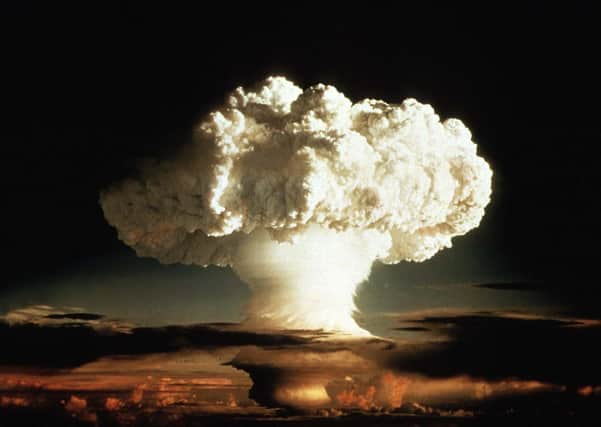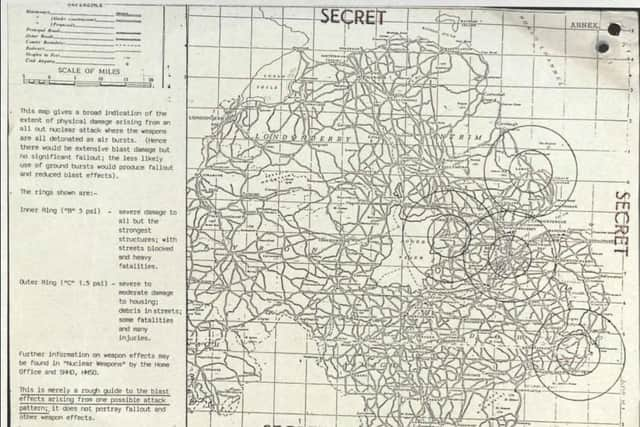Revealed after 37 years: The five Northern Ireland targets the Government expected the USSR to attack in a nuclear war


A file which has been declassified at the Public Record Office in Belfast after 37 years sets out in sobering detail the government’s expectation of how nuclear hostilities would destroy swathes of the east of Northern Ireland.
In September 1983, a document with the security classification of secret was given to a small number of officials at Stormont with a cover note setting out strict terms in which it was to be handled.
Advertisement
Hide AdAdvertisement
Hide AdIts distribution had been “strictly limited”, those having access to it would have to account for it at least once a year, it was not to be copied or disclosed and it had to be kept in a registered file or sealed double envelopes.


The document, which was sent to members of the Northern Ireland Home Defence Planning Committee, set out the planning assumptions for defending Northern Ireland in the event of a major war.
It said: “It seems likely that the Soviet Union’s military objective at the outbreak of hostilities would be to neutralise the UK capacity to wage war rather than to disrupt the economic life of the country or destroy centres of population.
“Whilst the use of nuclear weapons at the outset cannot be ruled out there is likely to be an initial conventional phase of operations during which important military targets would be attacked with conventional bombs and missiles and possibly chemical weapons.
Advertisement
Hide AdAdvertisement
Hide Ad“(Chemical weapons are particularly suited to disrupting targets such as airfields and port facilities by denying access to the area except in protected clothing. Some produce a vapour hazard for considerable distances down wind; decontamination of large areas is not feasible.)”
It said that “sabotage by their Special Purpose Forces (SPF) is another possibility”, with “target 1” the highest priority in target in Northern Ireland.
An annex to the document reveals ‘target 1’ to be RAF Bishops Court, which had been part of the UK Military Air Traffic Service key to controlling airspace over the North Atlantic, although by the 1980s it was being wound down.
The airfield, which was attacked by the IRA in 1989, was sold in the 1990s, and is now a motorsport circuit.
Advertisement
Hide AdAdvertisement
Hide AdThe 1983 document said that attempts could also be made to infiltrate Soviet special forces from the Republic to Northern Ireland and then on to Great Britain.
It added: “The Soviets have more than enough nuclear weapons to include all the likely targets in NI as part of an all-out attack on NATO” but that this would represent “a worst case situation”.
The five most likely targets for nuclear attack were considered in order of probable threat to be RAF Bishops Court, Aldergrove airport (now Belfast International Airport), Larne Port, Belfast Port, and Belfast city.
It said that while there was likely to be a period of increasing tensions and signs of a move towards war before a nuclear attack, such a period “could be as little as 48 hours”.
Advertisement
Hide AdAdvertisement
Hide AdEven if there was a prolonged period of tensions before war, it said that the societal effect could be dramatic.
Civil transport would be requisitioned by the military to rapidly transport troops to continental Europe within 30 days, while fuel shortages and wider “public and commercial apprehension” could lead to disruption of the currency, food supplies and commodity markets, triggering increases in prices and shortages for the population.
It added that “if war seemed imminent or unavoidable, it could lead to “self-evacuation of essential workers, absenteeism and public order problems”.
FROM THE DECLASSIFEID FILES:
Advertisement
Hide AdAdvertisement
Hide AdAdvertisement
Hide AdAdvertisement
Hide AdAdvertisement
Hide AdAdvertisement
Hide Ad——— ———
A message from the Editor:
Thank you for reading this story on our website. While I have your attention, I also have an important request to make of you.
With the coronavirus lockdown having a major impact on many of our advertisers — and consequently the revenue we receive — we are more reliant than ever on you taking out a digital subscription.
Advertisement
Hide AdAdvertisement
Hide AdSubscribe to newsletter.co.uk and enjoy unlimited access to the best Northern Ireland and UK news and information online and on our app. With a digital subscription, you can read more than 5 articles, see fewer ads, enjoy faster load times, and get access to exclusive newsletters and content. Visit https://www.newsletter.co.uk/subscriptions now to sign up.
Our journalism costs money and we rely on advertising, print and digital revenues to help to support them. By supporting us, we are able to support you in providing trusted, fact-checked content for this website.
Alistair Bushe
Editor